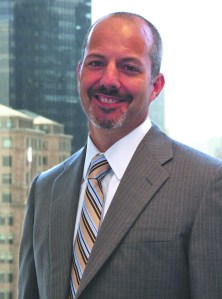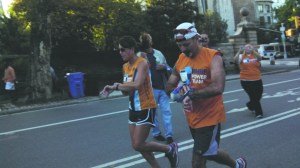Last Monday, CBRE’s Eric Gelber showed up for work weighing 10 pounds lighter. After the physical feat he completed over the weekend, it was a wonder he even made it through the door.
“They all looked at me like, ‘Are you crazy?’” he said of his CBRE colleagues.
 Mr. Gelber, 46, captured the collective mind of the real estate, running and cancer research communities, in the heart of the city, when he embarked on an epic 48-hour, 33-lap run around Central Park, beginning at 8 a.m. on Sept. 20 and ending at roughly the same time on Sept. 22.
Mr. Gelber, 46, captured the collective mind of the real estate, running and cancer research communities, in the heart of the city, when he embarked on an epic 48-hour, 33-lap run around Central Park, beginning at 8 a.m. on Sept. 20 and ending at roughly the same time on Sept. 22.
Dehydration, blisters and severe nausea didn’t stop the married father of three from completing the 164-mile ordeal, which raked in more than $104,000, and counting, for multiple myeloma research through the Multiple Myeloma Research Foundation.
“I knew New York would come through, and they did it in a big way,” Mr. Gelber, a senior vice president with CBRE’s tristate retail group, said in an interview with The Commercial Observer on Wednesday. “I am still overwhelmed with the amount we raised, and we’re still getting donations every day.”
The race took almost five months of preparation, working out six days per week, with frequent, back-to-back 30-mile Saturday and Sunday runs, Mr. Gelber said. A mostly liquid diet of powders and gels diluted in water, about 15,000 calories worth, broken up into 30 and 40 ounces per hour, along with roughly 35 minutes of seated nap time, supplied energy during the race.
Mr. Gelber parsed no words regarding the excruciating nature of the challenge. It was at times frustrating, exhausting and taxing on the body. A stubborn, recurring nausea culminated in a bout of vomiting at 3 a.m. on Saturday.
 “I was feeling nauseous well before that, and I was never able to kick that feeling,” Mr. Gelber said. “It can get pretty frustrating when it gets to that point. I’m pretty exhausted, sore, and everything hurts. The feet are the worst thing. But you know what you’re there for. And you keep pushing, one step at a time.”
“I was feeling nauseous well before that, and I was never able to kick that feeling,” Mr. Gelber said. “It can get pretty frustrating when it gets to that point. I’m pretty exhausted, sore, and everything hurts. The feet are the worst thing. But you know what you’re there for. And you keep pushing, one step at a time.”
While the nausea was unrelenting, so was the support from friends, colleagues and random passersby, who, along with the calorie-rich liquid diet and the resolve of the cancer research community, gave Mr. Gelber the motivation to plow through.
A crew of 10 people, including his wife, Tani, other family members and CBRE colleagues, held down camp at the start line. Dozens of people who pledged to run and donate ran alongside him throughout the run. Others dropped in randomly, while a little help from Metallica and Adele went a long way to fill in the gaps.
“I was laughing during one of the nights, because I have a whole variety of things on my playlist, and at one point it went from Master of Puppets to Adele back to back,” Mr. Gelber said.
Mr. Gelber started the first loop of the race with multiple myeloma patient Sally Kalksma, from Pine Beach, N.J., who has taken on the Empire State Building Run-Up, which benefits the MMRF, the last two years.
“I am so touched that he literally puts his body on the line again and again to help fund critical research that is helping myeloma patients like me,” Ms. Kalksma said before the race.
Two other multiple myeloma patients, Jean Dreyer and Carmen Phaneuf, joined him during the final six-mile loop around the park.

“We had a pretty emotional hug,” Mr. Gelber said. “They were thanking me for what I did, and I was thanking them for inspiring me to do it. We’re all fighting for the same thing. I can’t imagine being sick. I can’t imagine being in the position they are in. I mean, they came out to run. That’s just amazing.
“They don’t have a choice. They can’t stop. And I choose to keep going for them.”
Mr. Gelber had at least two people running alongside him during the race, through rain, cold and the thick of the night, from family members to the dozens of CBRE colleagues to the random construction workers and others who jumped in, donating food, umbrellas and money.
“People showed up at all hours of the day and night,” he said. “These were people I’d never met before.”
“The hard part was, when people would come and jump in, I wanted to talk to them and learn about them and answer questions, but it becomes exhausting,” he added. “If you’re laughing and running, it wears you out. So I would let them know I needed to focus on what I was doing, and they understood completely.”



